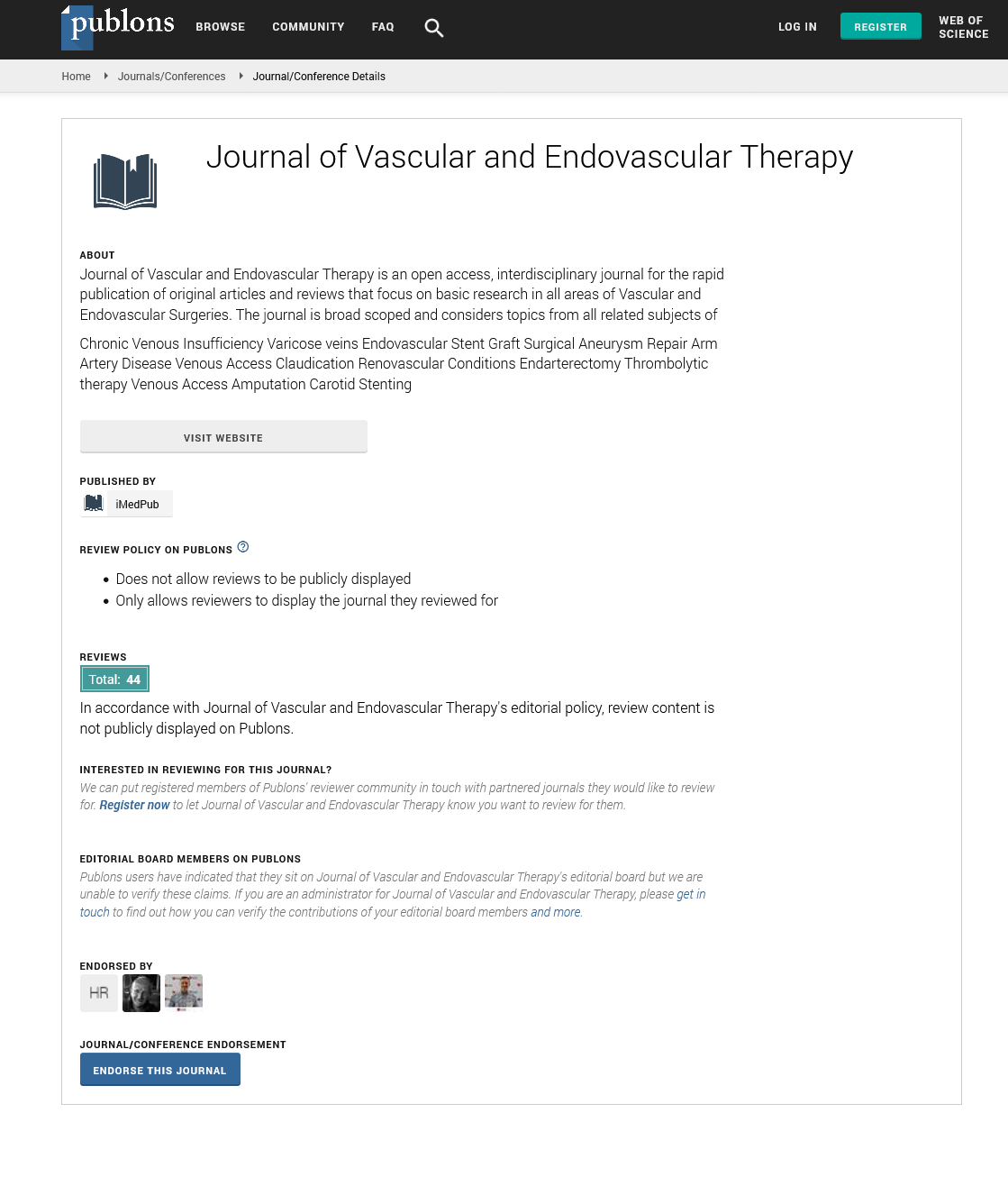ISSN : 2634-7156
Journal of Vascular and Endovascular Therapy
The role of neutrophils in abdominal aortic aneurysms
3rd Edition of World Congress & Exhibition on Vascular Surgery
May 24-25, 2018 London, UK
Christoph Neumayer
Medical University Vienna, Austria
Keynote: J Vasc Endovasc Therapy
DOI: 10.21767/2573-4482-C1-001
Abstract
Neutrophil extracellular cells have emerged to be more important in their role of inflammatory responses than phagocytic actions. Recent publications showed neutrophils to be involved in the activation of the IL-1 family and subsequent distribution of neutrophil proteases to the inflammatory site. The abdominal aortic aneurysm (AAA) is considered a chronic inflammatory disease with neutrophils recruited to the aneurysm site and intraluminal thombus, releasing neutrophil proteases and reactive oxygen species, which contribute to media destruction. D-Dimer and myeloperoxidase, distinctive neutrophil proteases have evolved as potential sensitive AAA markers, supporting the hypothesis of neutrophils to be key players in AAA pathogenesis. During the recruitment of neutrophils to the aneurysm site and intraluminal thrombus, activated neutrophils may undergo the process of NETosis, which involves histone modification by citrullination, allowing the DNA to be condensated and subsequent DNA and sticky traps release into the extracellular space. These NETs are recently discussed to be a potential biomarker in AAA pathogenesis. NETs were found in AAA mouse model and its inhibition prevented AAA development. Furthermore, anti-inflammatory treatment such as metformin in diabetic patients was associated with reduced AAA growth. The potential therapeutic approach of metformin in systemic lupus erythematodous could already be elucidated by reduced inflammatory skin flares through reduced NET formation. In summary, neutrophils, neutrophil proteases and NETs are intensively discussed as potential biomarkers in AAA, this lecture will give an overview of all recent findings on neutrophils and their products in AAA. Recent Publications 1. Piechota-Polanczyk A, Jozkowicz A, Nowak W, Eilenberg W, Neumayer C, Malinski T, Huk I and Brostjan C (2015): The abdominal aortic aneurysm and intraluminal thrombus: current concepts of development and treatment(review). 2015 Front. Cardiovasc. Med. 2015
Volume 2 Article 19 2. W. Eilenberg, S. Stojkovic, A. Piechota-Polanczyk, C. Kaun, S. Rauscher, M. Gröger, M. Klinger, J. Wojta, C. Neumayer, I. Huk, S. Demyanets. Neutrophil Gelatinase-Associated Lipocalin (NGAL) is associated with symptomatic carotid atherosclerosis and drives pro-inflammatory state in vitro Eur J Vasc Endovasc Surg (2016) 51(5):623-31 3. W. Eilenberg, S. Stojkovic, A. Kaider, N. Kozakowski, C.M. Domenig, C. Burghuber, J. Nanobachvili, K. Huber, C. Neumayer, I. Huk, J. Wojta, S. Demyanets. NGAL and MMP-9/NGAL as biomarkers of plaque vulnerability and targets of statins in patients with carotid atherosclerosis. Clinical Chemistry and Laboratory Medicine. (2017) June 4. W. Eilenberg, S. Stojkovic, A. Piechota-Polanczyk, A. Kaider, N. Kozakowski, W. Weninger, J. Nanobachvili, J. Wojta, I. Huk, S. Demyanets, C. Neumayer. Neutrophil Gelatinase Associated Lipocalin (NGAL) is elevated in type 2 diabetics with carotid artery stenosis and reduced under metformin treatment. Cardiovascular Diabetology (2017) 16:98 5. Jab√?¬?o√?¬?ska A, Neumayer C, Bolliger M, Gollackner B, Klinger M, Paradowska E, Nanobachvili J, Huk I. Analysis of host Toll-like receptor 3 and RIG-I-like receptor gene expression in patients with abdominal aortic aneurysm. J Vasc Surg. 2018 Mar 19. S0741-5214(17)32687-3.
Biography
Prof. Christoph Neumayer is the interim head of the division of Vascular Surgery, Department of Surgery, Medical University Vienna. His main research focus inherits carotid atherosclerosis and the abdominal aortic aneurysm, especially basic research models of AAA in mice and novel therapy options.
Email:christoph.neumayer@meduniwien.ac.at
Google Scholar citation report
Citations : 177
Journal of Vascular and Endovascular Therapy received 177 citations as per Google Scholar report
Journal of Vascular and Endovascular Therapy peer review process verified at publons
Abstracted/Indexed in
- Google Scholar
- Open J Gate
- Publons
- Geneva Foundation for Medical Education and Research
- Secret Search Engine Labs
Open Access Journals
- Aquaculture & Veterinary Science
- Chemistry & Chemical Sciences
- Clinical Sciences
- Engineering
- General Science
- Genetics & Molecular Biology
- Health Care & Nursing
- Immunology & Microbiology
- Materials Science
- Mathematics & Physics
- Medical Sciences
- Neurology & Psychiatry
- Oncology & Cancer Science
- Pharmaceutical Sciences
